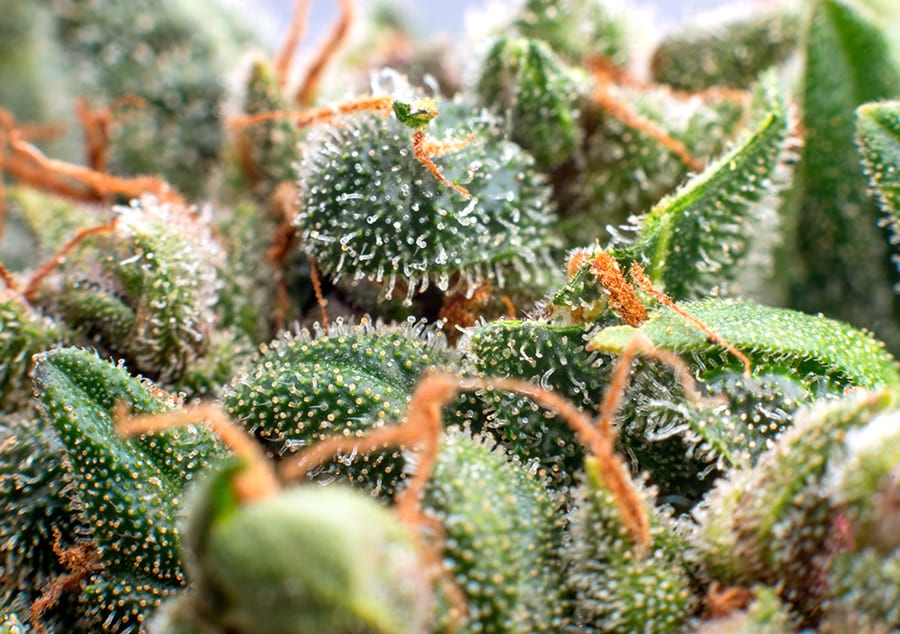Cannabinoids like cannabidiol (CBD), tetrahydrocannabinol (THC), cannabidiol (CBG), and others are often the focus of discussions about the therapeutic potential of the cannabis plant.
Cannabinoids aren’t the only powerful medicinal compounds in Cannabis; terpenes also possess powerful potential healing properties, both alone and in combination with other cannabis compounds, to deliver a wide range of potential health benefits. Terpenes are present in the air whenever you take a deep breath of an aromatic plant, like lavender. Many plants, including Cannabis, lavender, pine, and oranges, have distinctive aromas because of aromatic compounds called terpenes. Yet these chemicals serve more than to give hemp and other plants their distinctive scents. Terpenes provide defense for the plant and may have therapeutic effects when ingested by humans. Keep reading to learn about terpene benefits.
WHAT ARE TERPENES
Terpenes are the most abundant and varied class of organic compounds. They can be broken down into mono-, di-, tri-, tetra-, and sesquiterpenes, depending on how many isoprene units they contain. They make up the bulk of plant essential oils and can be found in most plant-based foods. According to Loughrin et al. (2001), terpenes are exceptionally fragrant chemicals that give many plants and herbs their distinctive aromas, including rosemary, lavender, and even certain animals. Terpenes perform various functions, from attracting pollinators (such as bees) to warding off harmful or invasive organisms. The distinctive and “skunky” odors of different cannabis strains have long been attributed to volatile sulfur compounds (VSCs). terpenes play a significant role; if not the whole aroma, at least a significant portion of it comes from the terpenes in your preferred cannabis strain.
BENEFITS OF TERPENES
Terpenes and terpenoids have numerous biological and pharmacological functions, including antifungal, antiviral, anticancer, anti-inflammatory, antihyperglycemic, antioxidant, antiparasitic, and antimicrobial. Below are several possible health advantages.
PROTECTION AGAINST DISEASES
Different species, from bacteria to animals to plants, benefit from terpene’s ability to defend them against environmental and predatory threats. Terpene can protect a plant against disease, predators, and other species. Terpene is used by many creatures, including humans, for medical purposes and signaling about food, partners, or adversaries. Although terpene includes various forms and types, it is remarkable how many different creatures employ terpene for similar goals.
INSECT REPELLANT
The terpene is a healthy choice to fight off insects without employing harsh chemicals that might have adverse effects. Numerous insecticides have been developed to eliminate common household pests, including lice and mites. It is crucial in these situations to ensure that these pesticides do not have any negative effects on human beings. Various possibilities, like shampoo, lotions, and sprays, were created against pests incorporating one or more terpenes utilized in the immediate innovation. These naturally occurring terpenes are normally not changed. They were utilized in their raw state, and the environment protection agency in the USA is categorized as “GRAS,” which means Generally Regards as Safe. George et al. (2014) suggested that due to their observed mechanisms of action, certain terpene is extremely efficient against both lice and lice eggs, and resistance to these pesticides is unlikely to emerge. Unlike other sorts of pediculosis treatment, these terpenes-based quick innovations are not neurotoxins.
ANTIMICROBIAL
Terpenes’ antimicrobial qualities, or their capacity to eradicate or halt the development of microorganisms, are often employed in conventional and contemporary medicine. Many terpenes have antibacterial properties. Pinus ponderosa (Pinaceae), spices (rosemary, sage, caraway, cumin, clove, and thyme), Helichrysum italicum, Cretan propolis, Rosmarinus officinalis, and other plants generate terpenes that have antibacterial characteristics. These antimicrobial terpenes have a broad range of antimicrobial activity and may be utilized against food-borne pathogens such as cell extract.
ANTI-INFLAMMATORY PROPERTIES OF TERPENES
According to modern medical research, almost every known animal illness may be traced back to persistent inflammation. Systemic chronic inflammation (SCI) is linked to many diseases, including cardiovascular disease, chronic kidney disease, diabetes mellitus, cancer, non-alcoholic fatty liver disease, autoimmune and neurodegenerative disorders, and, more recently, obesity. Sharma et al. (2017) revealed that reduced inflammation is achieved by terpenes’ inhibition of cytokine activity, a specialized kind of immune cell responsible for controlling inflammation. Several molecular targets, such as pro-inflammatory cytokines, autophagy machinery, transcription factors, reactive oxygen species (ROS), membrane receptors, and other inflammatory mediators, are involved in the pathogenesis of inflammatory diseases, terpenes, and terpenoids have shown promising results as alternative treatments. Consequently, terpenes may be more successful than current pharmaceuticals for treating inflammatory illnesses because they may simultaneously operate across many cell signaling channels.
PAIN-RELIEVING PROPERTIES
Although Cannabis has many medical uses, its most popular effect is probably the reduction of chronic pain. Terpenes are just as important as CBD and other cannabinoids when relieving pain. Alpha-humulene, geraniol, linalool, and beta-pinene are the four main terpenes in Cannabis. LaVigne et al. (2021) tested the effects of each terpene alone and in combination with WIN55,212-2. This synthetic cannabinoid agonist mimics the body’s effects of naturally occurring cannabinoids. When a cannabinoid like THC enters the body, it binds to the CB1R or CB2R cannabinoid receptors. When the receptor is engaged, neurons that control our bodies and actions become active. All four terpenes were found to activate the CB1R in laboratory experiments, similar to that of THC. Terpenes not only relieve pain by binding to cannabinoid receptors but also boost the effectiveness of cannabinoids by creating an “entourage effect.”
ANTIPLASMODIAL
Their ability to kill off malaria-causing plasmodium parasites has piqued interest as a possible antimalarial treatment. The antiviral effects of monoterpenes have been investigated. According to Beukes et al. (2014), certain terpenes have shown promise for cancer and diabetes treatment. Terpenes may be taken in several different ways, and they have been shown to lessen the adverse effects of several medications. Terpenes have the potential to enhance the cannabis experience while reducing any negative effects. THC binding to cannabinoid receptors and blood-brain barrier permeability may be affected by terpenes, a class of cannabis plant compounds. Some terpenes may mitigate the impairment of short-term memory caused by THC usage.
CONCLUSION
The therapeutic applications of terpenes are almost limitless. The health advantages of cannabis terpenes are just beginning to be explored. The large variety of cannabinoids and terpenes in Cannabis suggests that full-spectrum products may provide more comprehensive health advantages to consumers. This data should be used with caution. Most research on terpenes and health has been conducted using isolated chemicals and animal models. More study is necessary to fully understand the interconnected web of effects that terpenes and cannabinoids have. According to anecdotal evidence from aromatherapy patients, terpenes have been shown to provide several health advantages.
REFERENCES
Beukes, N., Levendal, R. A., & Frost, C. L. (2014). Selected terpenoids from medicinal plants modulate endoplasmic reticulum stress in metabolic disorders. Journal of Pharmacy and Pharmacology, 66(11), 1505-1525.
George, D. R., Finn, R. D., Graham, K. M., & Sparagano, O. A. (2014). Present and future potential of plant-derived products to control arthropods of veterinary and medical significance. Parasites & vectors, 7(1), 1-12.
LaVigne, J. E., Hecksel, R., Keresztes, A., & Streicher, J. M. (2021). Cannabis sativa terpenes are cannabimimetic and selectively enhance cannabinoid activity. Scientific reports, 11(1), 1-15.
Sharma, P., Kumar, P., Sharma, R., Gupta, G., & Chaudhary, A. (2017). Immunomodulators: Role of medicinal plants in the immune system. National Journal of Physiology, Pharmacy, and Pharmacology, 7(6), 552.
- What Are the 7 Chakras and How Can You Unblock Them? - April 19, 2024
- THCa Flower by Perfect Plant Markey - September 21, 2023
- Arches Audio Shares Their Secrets For Starting A Successful Podcast - July 7, 2023









